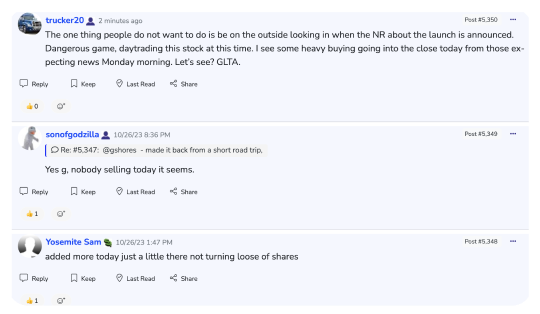Monday, February 18, 2013 7:32:31 PM
Shareholder Correspondence
by Eric Lehner
QUESTION
“…If and when you R/S, would you please post what an R/S is, I feel that it is misunderstood by many.
People are lead to believe that somehow their shares become worthless (Bashers have done well scaring people)….”
ANSWER
R/S is a short-form for Reverse Split. It is a method to reduce the number of shares outstanding without affecting the percentage ownership that people have. It is also known as a share consolidation.
For example, if a shareholder holds 1/2 of 1% of the ownership of the company with their current holding, then they will still have 1/2 of 1% after the share count is reduced because everybody’s shares are treated the same way. Because there are fewer shares outstanding, the market capitalization is distributed across a smaller number of shares, typically resulting in a proportionately higher share price. By itself, a Reverse Split is a neutral event.
What bashers are referring when they use phrases like shareholders being “wiped out” is that the share price often declines after a Reverse Split if the company does not have countervailing reasons for the price to remain stable or to increase. This is particularly important if the company continues equity financing after the Reverse Split (which is the normal thing to do). The goal of the company carrying out a Reverse Split should be to generate legitimate positive business developments as it carries on its business after the Reverse Split. The ability of a company to provide such off-setting positive factors will vary depending upon the circumstances of each company.
One important fact about which there is little dispute is that a Reverse Split generally ensures that the company can continue operating normally if it has financing difficulties due to a large float. Although it is easy to portray a Reverse Split as the worst possible development, a company’s continued positive operation is more beneficial for shareholders than its loss of momentum due to operational constraints, or an inability to meet comitments in a timely manner. That’s why even bashers will admit that the company’s continued operations can be ensured through a R/S.
In the case of Winning Brands, the attempt to avoid share issuance in 2012 has cost it operational momentum by depriving the firm of the resources needed to make the most of its opportunities. It should be remembered that the valuation of shares flows from the “market cap” which is established by the free market. Even after a post-split dip, the shares can recover and advance beyond where they were at the time of the split. The likelihood of this depends upon the company’s ability to achieve its business goals. In the case of Winning Brands, reference to the early years as a predictor of the future is flawed because of the assumption that all relevant factors remain unchanged. Much good has happened in the past 2 years which lays the foundation for greater advancement than anything which happened in the first 4. Spirited independent consumer product success stories almost never have a straight line success curve. The formative years are always the most difficult.
In summary, a Reverse Split is considered an unwelcome development in most cases, but can be in the long term interests of shareholders if the company’s renewed ability to raise funds yields positive operational results. Winning Brands is committed to its mission, and therefore can still accomplish what it needs to in order to be very successful.
This post has no tag
FEATURED POET and Luxshare Tech Expand Product Offerings for Artificial Intelligence Networks • Aug 1, 2024 9:28 AM
Management Discusses Financial Filings of Global Arena Holding Inc., for 10-K 2023 and 10-Q, 1st Quarter 2024 • GAHC • Aug 1, 2024 9:14 AM
VAYK Announces LOI to Acquire $1 Million Home Service Company to Support Airbnb Business • VAYK • Aug 1, 2024 9:00 AM
Duane Forrester Joins INDEXR as SVP of Search • MONI • Jul 31, 2024 11:46 AM
Lingerie Fighting Championships Help Fulfill Death-Bed Promise With First Major Motion Picture • BOTY • Jul 31, 2024 9:00 AM
Kona Gold Beverage Significantly Reduces Debt from Multiple Holders • KGKG • Jul 31, 2024 9:00 AM






